Kent St: MGT602 Business Decision Analytics - Style Analysis
VerifiedAdded on 2023/04/10
|11
|1659
|99
Report
AI Summary
This report delves into the realm of business decision analytics, focusing on the selection and evaluation of decision-making tools and their reflection on personal decision-making styles. It contrasts various styles to discern the levels of intuition and rationality involved, starting with an introduction to key terms like decision-making. The report outlines decisions made over a week, highlighting two major life decisions—relocating from Poland to France and a divorce—to evaluate decision-making preferences and the impact of personality strengths. It addresses cognitive biases, blind spots, and insights from classmates, using the divorce decision as a case study. Data sources and decision-making tools, such as brainstorming and decision matrix analysis, are examined. The report concludes with recommendations for improving decision-making styles by considering diverse aspects and utilizing decision tools to ensure comprehensive evaluation and appropriate selection, aiming to avoid future wrong decisions.
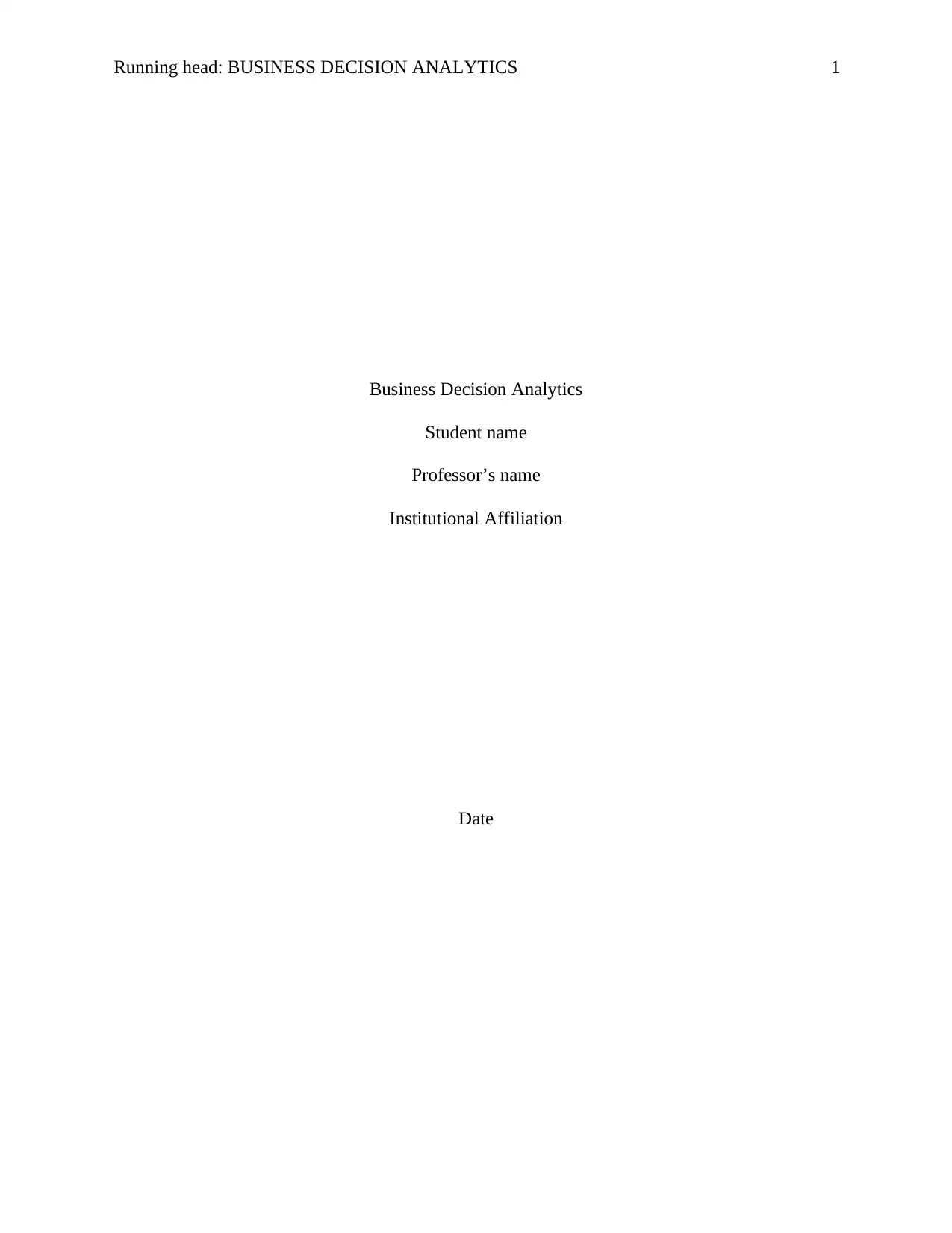
Running head: BUSINESS DECISION ANALYTICS 1
Business Decision Analytics
Student name
Professor’s name
Institutional Affiliation
Date
Business Decision Analytics
Student name
Professor’s name
Institutional Affiliation
Date
Paraphrase This Document
Need a fresh take? Get an instant paraphrase of this document with our AI Paraphraser
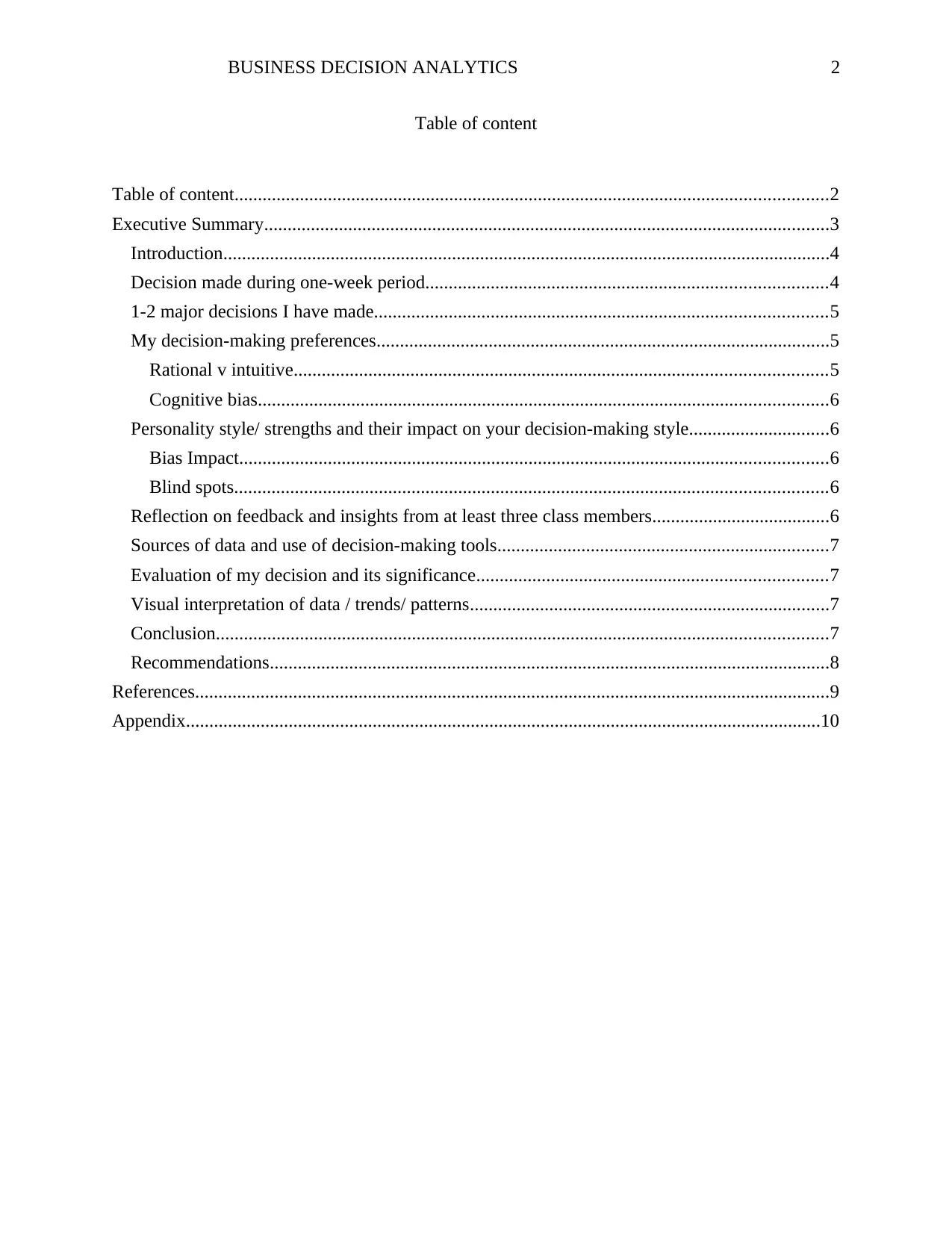
BUSINESS DECISION ANALYTICS 2
Table of content
Table of content...............................................................................................................................2
Executive Summary.........................................................................................................................3
Introduction..................................................................................................................................4
Decision made during one-week period......................................................................................4
1-2 major decisions I have made.................................................................................................5
My decision-making preferences.................................................................................................5
Rational v intuitive..................................................................................................................5
Cognitive bias..........................................................................................................................6
Personality style/ strengths and their impact on your decision-making style..............................6
Bias Impact..............................................................................................................................6
Blind spots...............................................................................................................................6
Reflection on feedback and insights from at least three class members......................................6
Sources of data and use of decision-making tools.......................................................................7
Evaluation of my decision and its significance...........................................................................7
Visual interpretation of data / trends/ patterns.............................................................................7
Conclusion...................................................................................................................................7
Recommendations........................................................................................................................8
References........................................................................................................................................9
Appendix........................................................................................................................................10
Table of content
Table of content...............................................................................................................................2
Executive Summary.........................................................................................................................3
Introduction..................................................................................................................................4
Decision made during one-week period......................................................................................4
1-2 major decisions I have made.................................................................................................5
My decision-making preferences.................................................................................................5
Rational v intuitive..................................................................................................................5
Cognitive bias..........................................................................................................................6
Personality style/ strengths and their impact on your decision-making style..............................6
Bias Impact..............................................................................................................................6
Blind spots...............................................................................................................................6
Reflection on feedback and insights from at least three class members......................................6
Sources of data and use of decision-making tools.......................................................................7
Evaluation of my decision and its significance...........................................................................7
Visual interpretation of data / trends/ patterns.............................................................................7
Conclusion...................................................................................................................................7
Recommendations........................................................................................................................8
References........................................................................................................................................9
Appendix........................................................................................................................................10
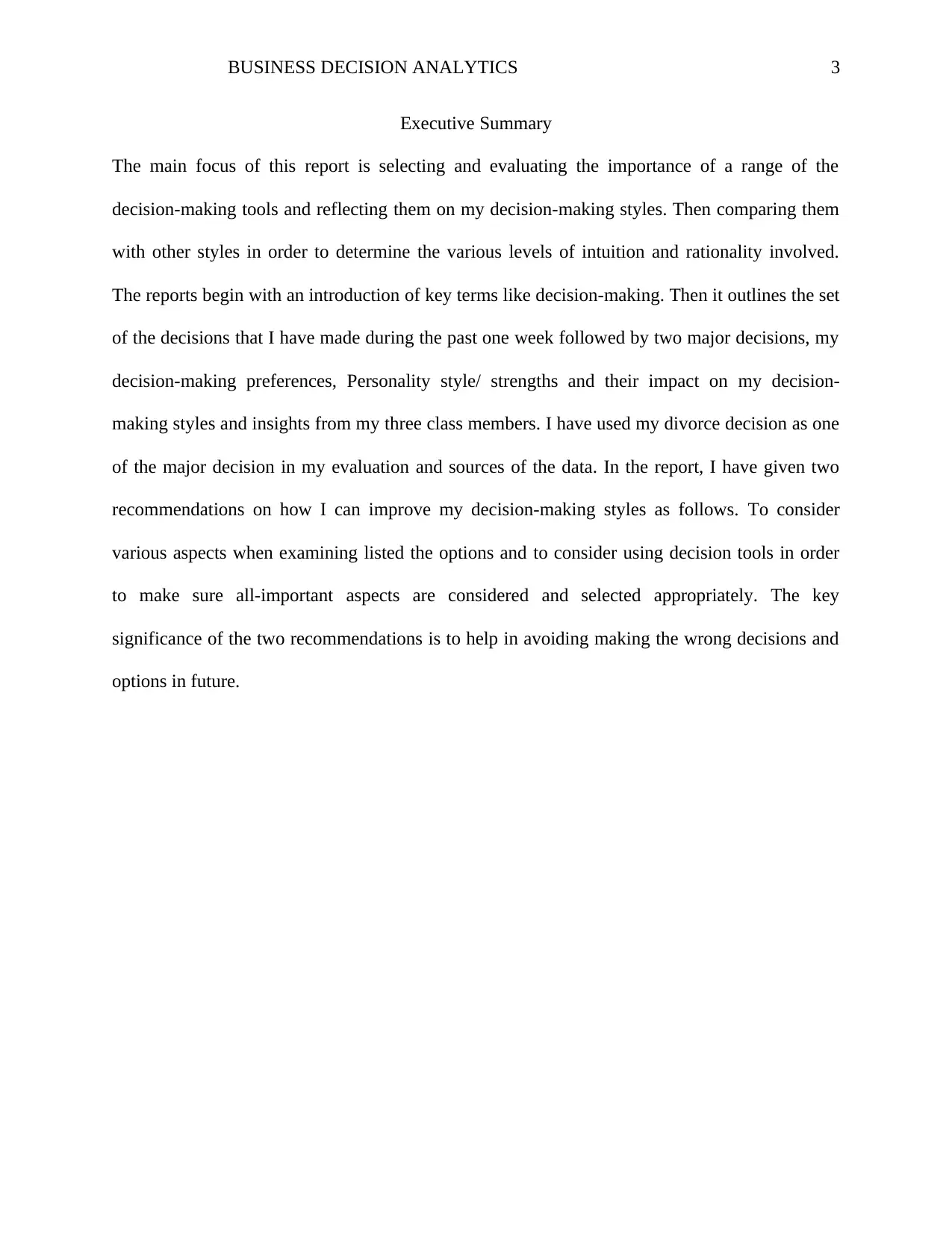
BUSINESS DECISION ANALYTICS 3
Executive Summary
The main focus of this report is selecting and evaluating the importance of a range of the
decision-making tools and reflecting them on my decision-making styles. Then comparing them
with other styles in order to determine the various levels of intuition and rationality involved.
The reports begin with an introduction of key terms like decision-making. Then it outlines the set
of the decisions that I have made during the past one week followed by two major decisions, my
decision-making preferences, Personality style/ strengths and their impact on my decision-
making styles and insights from my three class members. I have used my divorce decision as one
of the major decision in my evaluation and sources of the data. In the report, I have given two
recommendations on how I can improve my decision-making styles as follows. To consider
various aspects when examining listed the options and to consider using decision tools in order
to make sure all-important aspects are considered and selected appropriately. The key
significance of the two recommendations is to help in avoiding making the wrong decisions and
options in future.
Executive Summary
The main focus of this report is selecting and evaluating the importance of a range of the
decision-making tools and reflecting them on my decision-making styles. Then comparing them
with other styles in order to determine the various levels of intuition and rationality involved.
The reports begin with an introduction of key terms like decision-making. Then it outlines the set
of the decisions that I have made during the past one week followed by two major decisions, my
decision-making preferences, Personality style/ strengths and their impact on my decision-
making styles and insights from my three class members. I have used my divorce decision as one
of the major decision in my evaluation and sources of the data. In the report, I have given two
recommendations on how I can improve my decision-making styles as follows. To consider
various aspects when examining listed the options and to consider using decision tools in order
to make sure all-important aspects are considered and selected appropriately. The key
significance of the two recommendations is to help in avoiding making the wrong decisions and
options in future.
⊘ This is a preview!⊘
Do you want full access?
Subscribe today to unlock all pages.

Trusted by 1+ million students worldwide
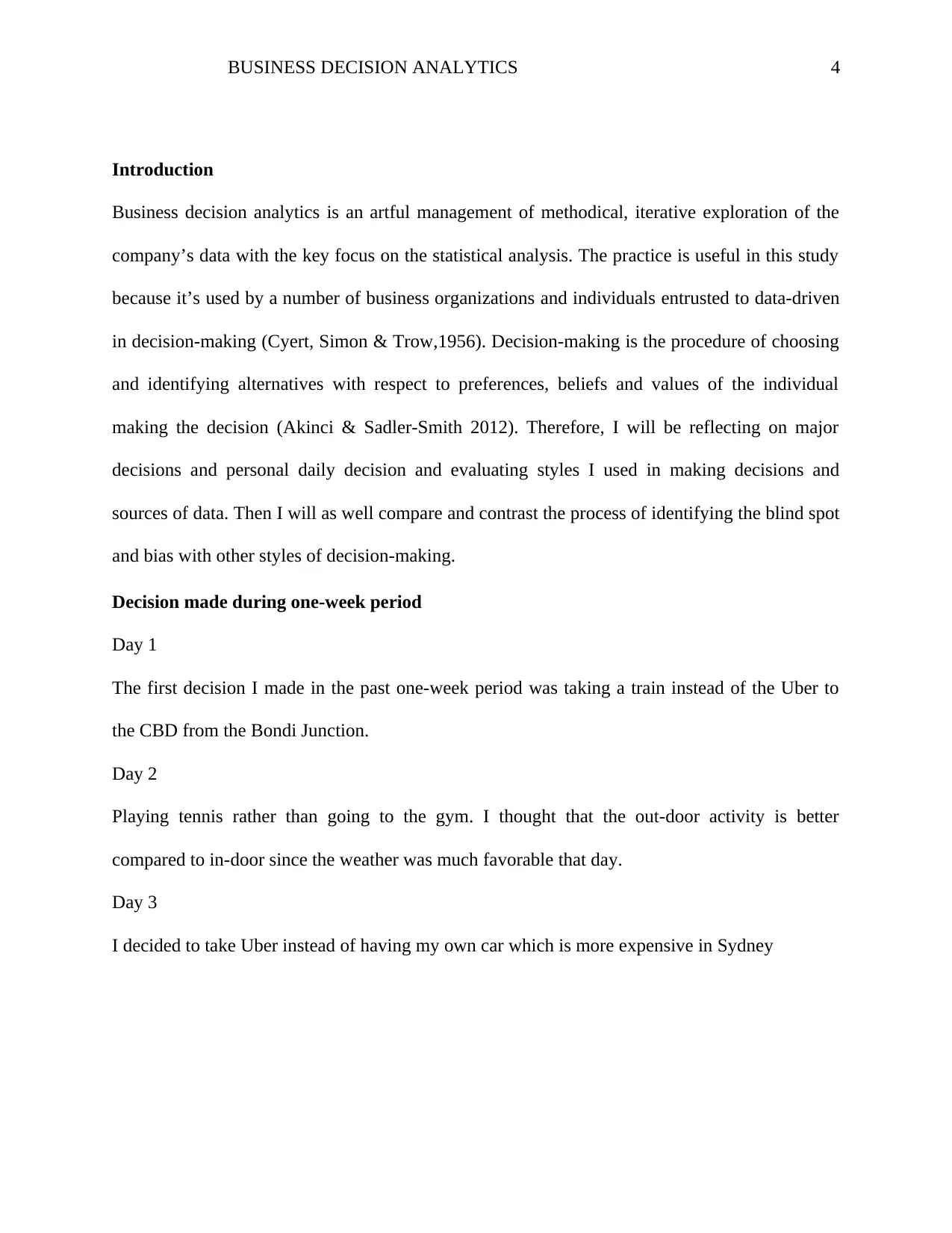
BUSINESS DECISION ANALYTICS 4
Introduction
Business decision analytics is an artful management of methodical, iterative exploration of the
company’s data with the key focus on the statistical analysis. The practice is useful in this study
because it’s used by a number of business organizations and individuals entrusted to data-driven
in decision-making (Cyert, Simon & Trow,1956). Decision-making is the procedure of choosing
and identifying alternatives with respect to preferences, beliefs and values of the individual
making the decision (Akinci & Sadler‐Smith 2012). Therefore, I will be reflecting on major
decisions and personal daily decision and evaluating styles I used in making decisions and
sources of data. Then I will as well compare and contrast the process of identifying the blind spot
and bias with other styles of decision-making.
Decision made during one-week period
Day 1
The first decision I made in the past one-week period was taking a train instead of the Uber to
the CBD from the Bondi Junction.
Day 2
Playing tennis rather than going to the gym. I thought that the out-door activity is better
compared to in-door since the weather was much favorable that day.
Day 3
I decided to take Uber instead of having my own car which is more expensive in Sydney
Introduction
Business decision analytics is an artful management of methodical, iterative exploration of the
company’s data with the key focus on the statistical analysis. The practice is useful in this study
because it’s used by a number of business organizations and individuals entrusted to data-driven
in decision-making (Cyert, Simon & Trow,1956). Decision-making is the procedure of choosing
and identifying alternatives with respect to preferences, beliefs and values of the individual
making the decision (Akinci & Sadler‐Smith 2012). Therefore, I will be reflecting on major
decisions and personal daily decision and evaluating styles I used in making decisions and
sources of data. Then I will as well compare and contrast the process of identifying the blind spot
and bias with other styles of decision-making.
Decision made during one-week period
Day 1
The first decision I made in the past one-week period was taking a train instead of the Uber to
the CBD from the Bondi Junction.
Day 2
Playing tennis rather than going to the gym. I thought that the out-door activity is better
compared to in-door since the weather was much favorable that day.
Day 3
I decided to take Uber instead of having my own car which is more expensive in Sydney
Paraphrase This Document
Need a fresh take? Get an instant paraphrase of this document with our AI Paraphraser
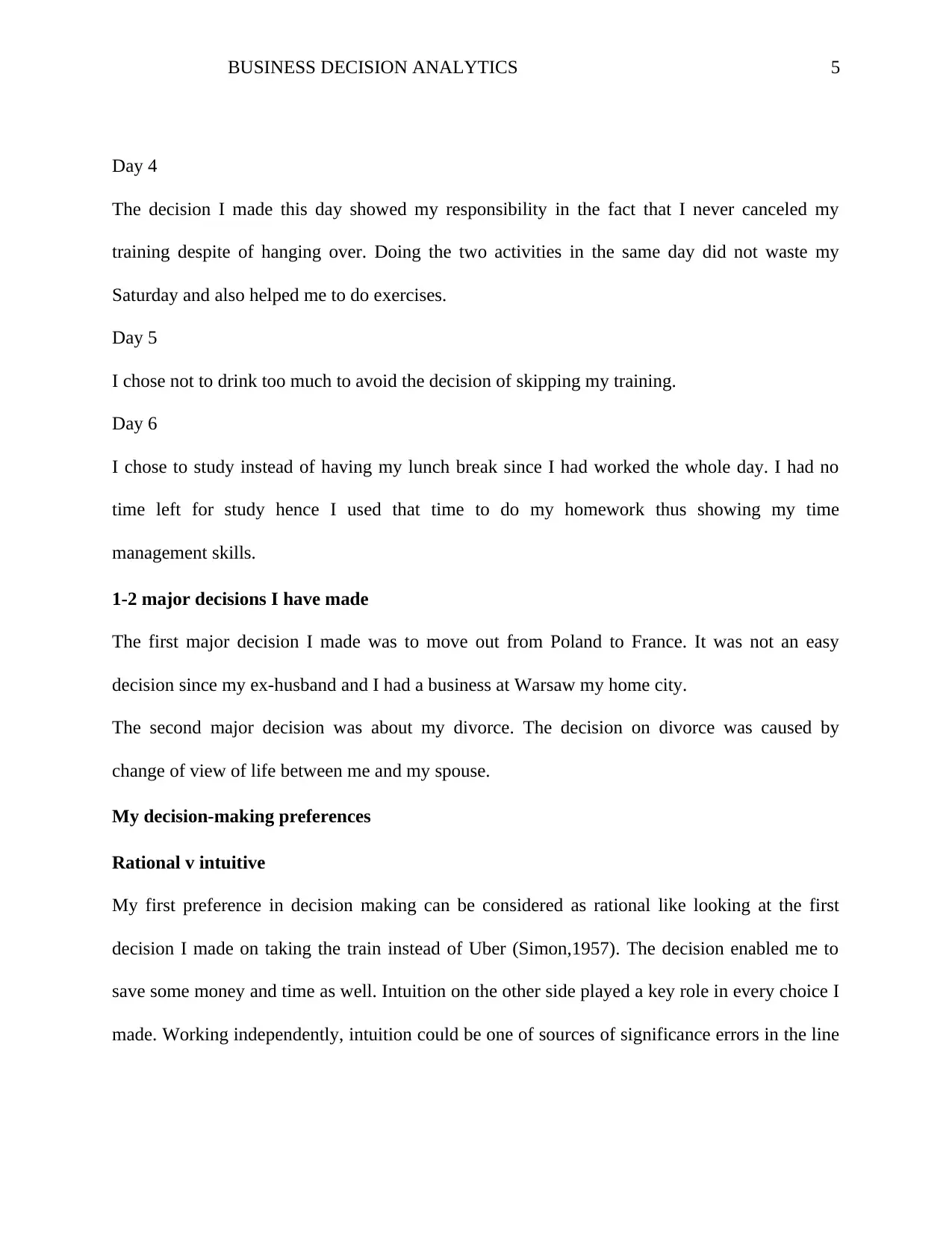
BUSINESS DECISION ANALYTICS 5
Day 4
The decision I made this day showed my responsibility in the fact that I never canceled my
training despite of hanging over. Doing the two activities in the same day did not waste my
Saturday and also helped me to do exercises.
Day 5
I chose not to drink too much to avoid the decision of skipping my training.
Day 6
I chose to study instead of having my lunch break since I had worked the whole day. I had no
time left for study hence I used that time to do my homework thus showing my time
management skills.
1-2 major decisions I have made
The first major decision I made was to move out from Poland to France. It was not an easy
decision since my ex-husband and I had a business at Warsaw my home city.
The second major decision was about my divorce. The decision on divorce was caused by
change of view of life between me and my spouse.
My decision-making preferences
Rational v intuitive
My first preference in decision making can be considered as rational like looking at the first
decision I made on taking the train instead of Uber (Simon,1957). The decision enabled me to
save some money and time as well. Intuition on the other side played a key role in every choice I
made. Working independently, intuition could be one of sources of significance errors in the line
Day 4
The decision I made this day showed my responsibility in the fact that I never canceled my
training despite of hanging over. Doing the two activities in the same day did not waste my
Saturday and also helped me to do exercises.
Day 5
I chose not to drink too much to avoid the decision of skipping my training.
Day 6
I chose to study instead of having my lunch break since I had worked the whole day. I had no
time left for study hence I used that time to do my homework thus showing my time
management skills.
1-2 major decisions I have made
The first major decision I made was to move out from Poland to France. It was not an easy
decision since my ex-husband and I had a business at Warsaw my home city.
The second major decision was about my divorce. The decision on divorce was caused by
change of view of life between me and my spouse.
My decision-making preferences
Rational v intuitive
My first preference in decision making can be considered as rational like looking at the first
decision I made on taking the train instead of Uber (Simon,1957). The decision enabled me to
save some money and time as well. Intuition on the other side played a key role in every choice I
made. Working independently, intuition could be one of sources of significance errors in the line
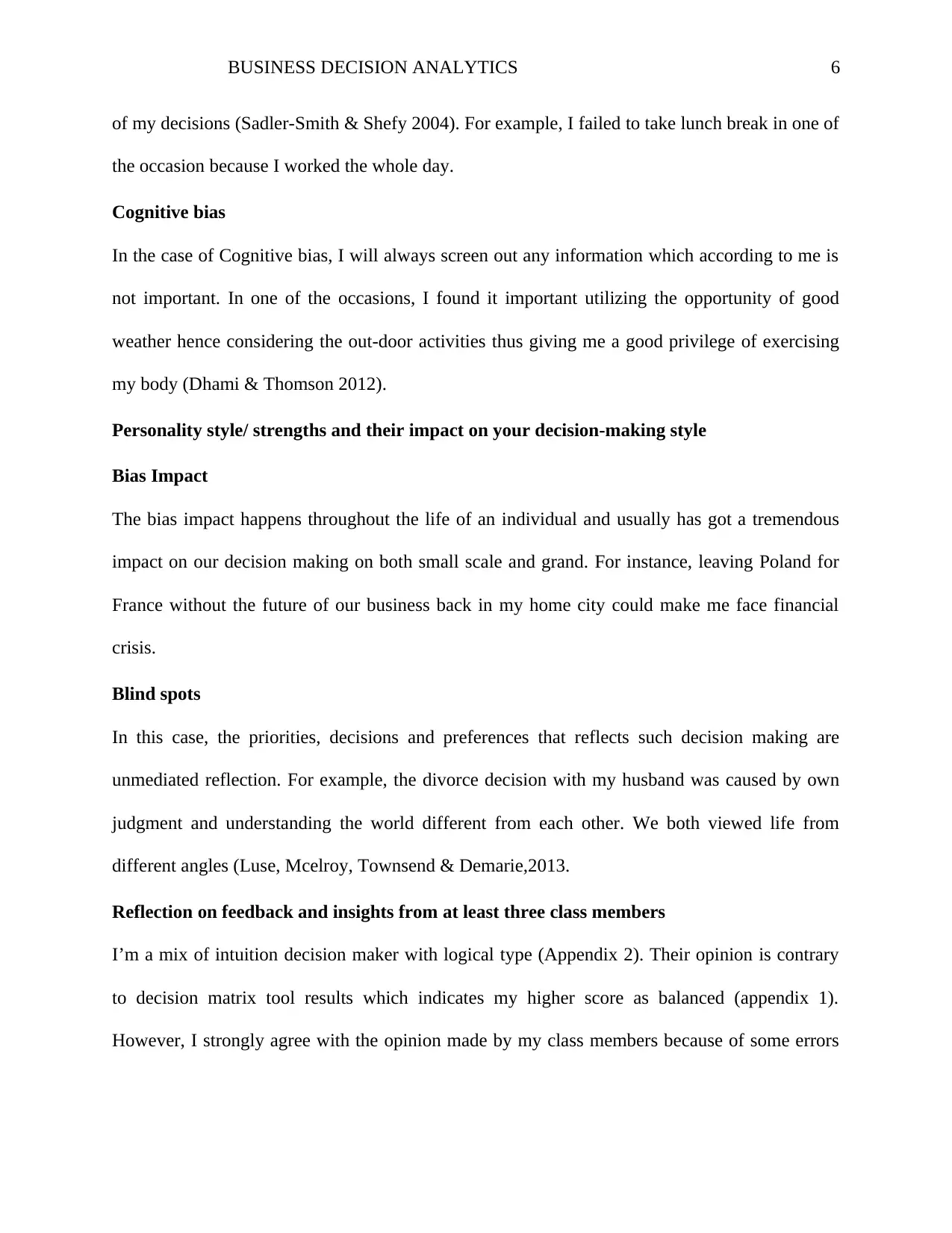
BUSINESS DECISION ANALYTICS 6
of my decisions (Sadler-Smith & Shefy 2004). For example, I failed to take lunch break in one of
the occasion because I worked the whole day.
Cognitive bias
In the case of Cognitive bias, I will always screen out any information which according to me is
not important. In one of the occasions, I found it important utilizing the opportunity of good
weather hence considering the out-door activities thus giving me a good privilege of exercising
my body (Dhami & Thomson 2012).
Personality style/ strengths and their impact on your decision-making style
Bias Impact
The bias impact happens throughout the life of an individual and usually has got a tremendous
impact on our decision making on both small scale and grand. For instance, leaving Poland for
France without the future of our business back in my home city could make me face financial
crisis.
Blind spots
In this case, the priorities, decisions and preferences that reflects such decision making are
unmediated reflection. For example, the divorce decision with my husband was caused by own
judgment and understanding the world different from each other. We both viewed life from
different angles (Luse, Mcelroy, Townsend & Demarie,2013.
Reflection on feedback and insights from at least three class members
I’m a mix of intuition decision maker with logical type (Appendix 2). Their opinion is contrary
to decision matrix tool results which indicates my higher score as balanced (appendix 1).
However, I strongly agree with the opinion made by my class members because of some errors
of my decisions (Sadler-Smith & Shefy 2004). For example, I failed to take lunch break in one of
the occasion because I worked the whole day.
Cognitive bias
In the case of Cognitive bias, I will always screen out any information which according to me is
not important. In one of the occasions, I found it important utilizing the opportunity of good
weather hence considering the out-door activities thus giving me a good privilege of exercising
my body (Dhami & Thomson 2012).
Personality style/ strengths and their impact on your decision-making style
Bias Impact
The bias impact happens throughout the life of an individual and usually has got a tremendous
impact on our decision making on both small scale and grand. For instance, leaving Poland for
France without the future of our business back in my home city could make me face financial
crisis.
Blind spots
In this case, the priorities, decisions and preferences that reflects such decision making are
unmediated reflection. For example, the divorce decision with my husband was caused by own
judgment and understanding the world different from each other. We both viewed life from
different angles (Luse, Mcelroy, Townsend & Demarie,2013.
Reflection on feedback and insights from at least three class members
I’m a mix of intuition decision maker with logical type (Appendix 2). Their opinion is contrary
to decision matrix tool results which indicates my higher score as balanced (appendix 1).
However, I strongly agree with the opinion made by my class members because of some errors
⊘ This is a preview!⊘
Do you want full access?
Subscribe today to unlock all pages.

Trusted by 1+ million students worldwide
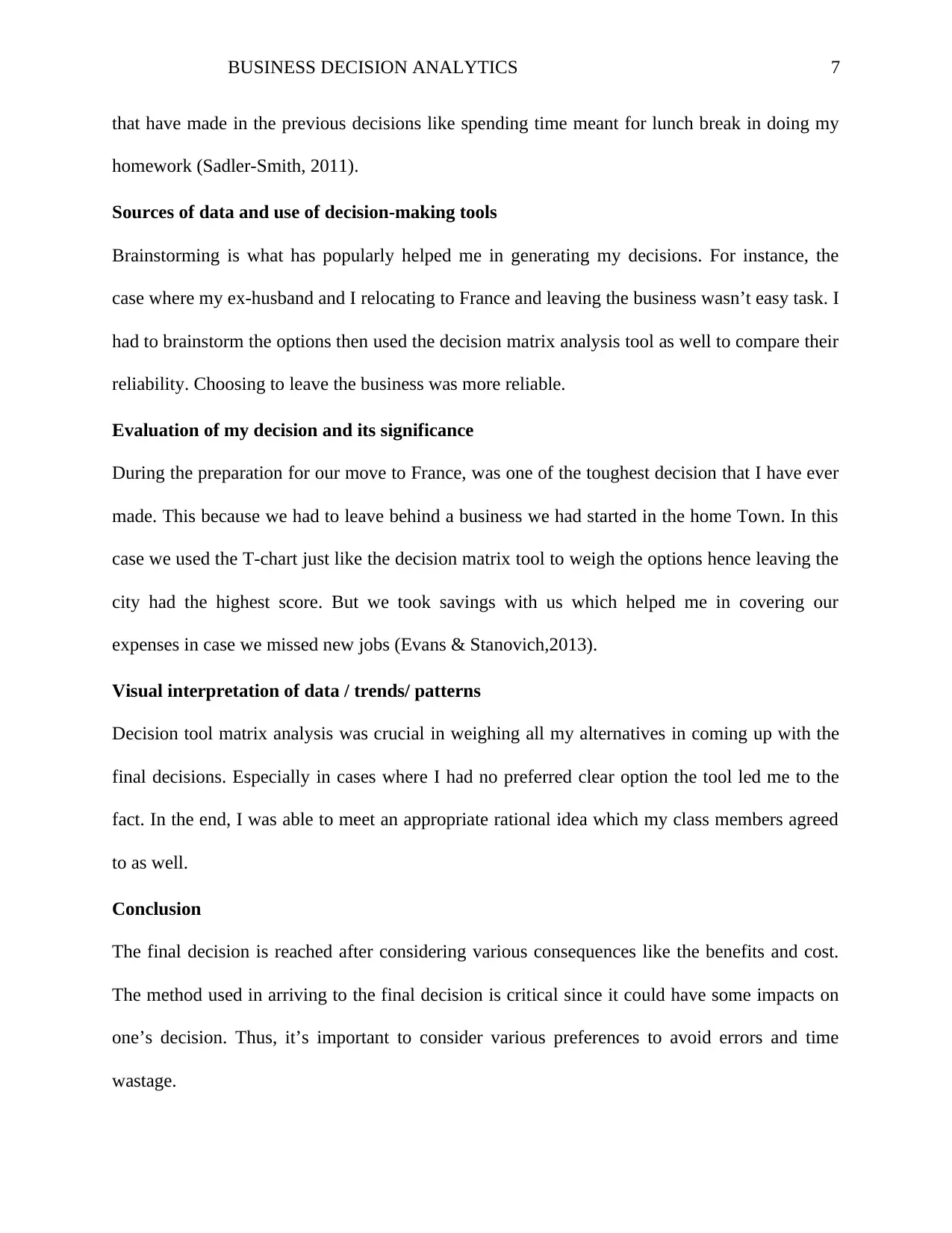
BUSINESS DECISION ANALYTICS 7
that have made in the previous decisions like spending time meant for lunch break in doing my
homework (Sadler-Smith, 2011).
Sources of data and use of decision-making tools
Brainstorming is what has popularly helped me in generating my decisions. For instance, the
case where my ex-husband and I relocating to France and leaving the business wasn’t easy task. I
had to brainstorm the options then used the decision matrix analysis tool as well to compare their
reliability. Choosing to leave the business was more reliable.
Evaluation of my decision and its significance
During the preparation for our move to France, was one of the toughest decision that I have ever
made. This because we had to leave behind a business we had started in the home Town. In this
case we used the T-chart just like the decision matrix tool to weigh the options hence leaving the
city had the highest score. But we took savings with us which helped me in covering our
expenses in case we missed new jobs (Evans & Stanovich,2013).
Visual interpretation of data / trends/ patterns
Decision tool matrix analysis was crucial in weighing all my alternatives in coming up with the
final decisions. Especially in cases where I had no preferred clear option the tool led me to the
fact. In the end, I was able to meet an appropriate rational idea which my class members agreed
to as well.
Conclusion
The final decision is reached after considering various consequences like the benefits and cost.
The method used in arriving to the final decision is critical since it could have some impacts on
one’s decision. Thus, it’s important to consider various preferences to avoid errors and time
wastage.
that have made in the previous decisions like spending time meant for lunch break in doing my
homework (Sadler-Smith, 2011).
Sources of data and use of decision-making tools
Brainstorming is what has popularly helped me in generating my decisions. For instance, the
case where my ex-husband and I relocating to France and leaving the business wasn’t easy task. I
had to brainstorm the options then used the decision matrix analysis tool as well to compare their
reliability. Choosing to leave the business was more reliable.
Evaluation of my decision and its significance
During the preparation for our move to France, was one of the toughest decision that I have ever
made. This because we had to leave behind a business we had started in the home Town. In this
case we used the T-chart just like the decision matrix tool to weigh the options hence leaving the
city had the highest score. But we took savings with us which helped me in covering our
expenses in case we missed new jobs (Evans & Stanovich,2013).
Visual interpretation of data / trends/ patterns
Decision tool matrix analysis was crucial in weighing all my alternatives in coming up with the
final decisions. Especially in cases where I had no preferred clear option the tool led me to the
fact. In the end, I was able to meet an appropriate rational idea which my class members agreed
to as well.
Conclusion
The final decision is reached after considering various consequences like the benefits and cost.
The method used in arriving to the final decision is critical since it could have some impacts on
one’s decision. Thus, it’s important to consider various preferences to avoid errors and time
wastage.
Paraphrase This Document
Need a fresh take? Get an instant paraphrase of this document with our AI Paraphraser
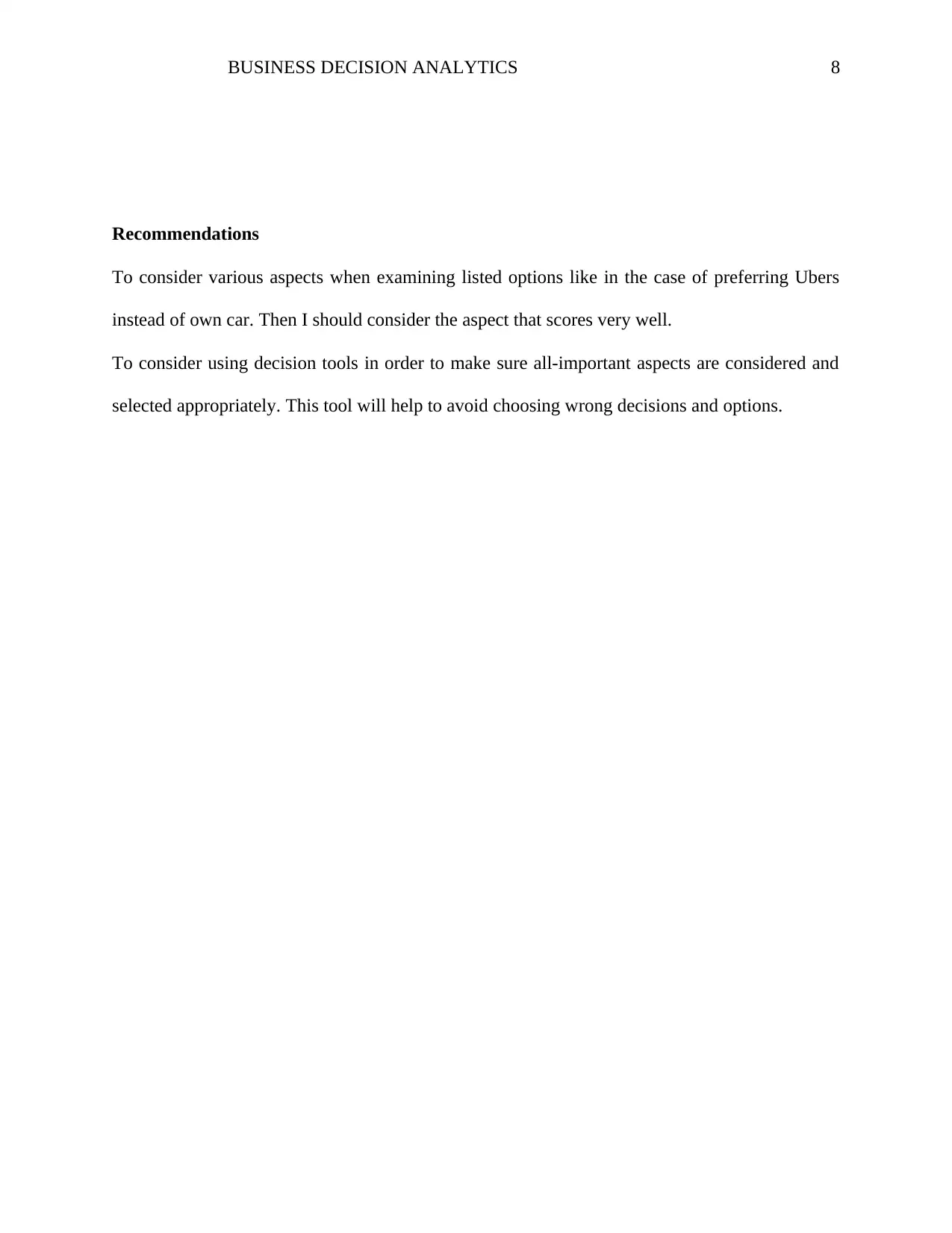
BUSINESS DECISION ANALYTICS 8
Recommendations
To consider various aspects when examining listed options like in the case of preferring Ubers
instead of own car. Then I should consider the aspect that scores very well.
To consider using decision tools in order to make sure all-important aspects are considered and
selected appropriately. This tool will help to avoid choosing wrong decisions and options.
Recommendations
To consider various aspects when examining listed options like in the case of preferring Ubers
instead of own car. Then I should consider the aspect that scores very well.
To consider using decision tools in order to make sure all-important aspects are considered and
selected appropriately. This tool will help to avoid choosing wrong decisions and options.
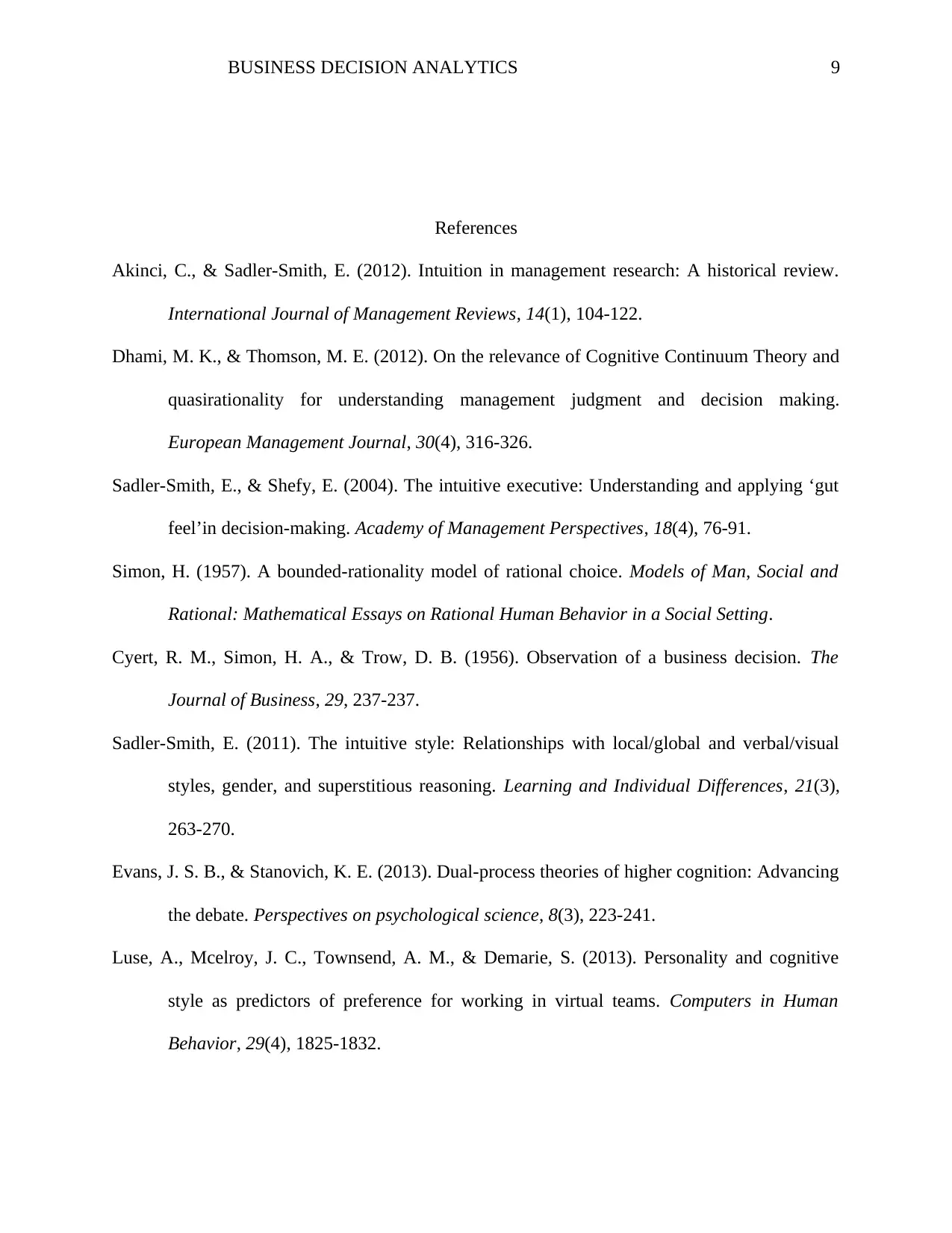
BUSINESS DECISION ANALYTICS 9
References
Akinci, C., & Sadler‐Smith, E. (2012). Intuition in management research: A historical review.
International Journal of Management Reviews, 14(1), 104-122.
Dhami, M. K., & Thomson, M. E. (2012). On the relevance of Cognitive Continuum Theory and
quasirationality for understanding management judgment and decision making.
European Management Journal, 30(4), 316-326.
Sadler-Smith, E., & Shefy, E. (2004). The intuitive executive: Understanding and applying ‘gut
feel’in decision-making. Academy of Management Perspectives, 18(4), 76-91.
Simon, H. (1957). A bounded-rationality model of rational choice. Models of Man, Social and
Rational: Mathematical Essays on Rational Human Behavior in a Social Setting.
Cyert, R. M., Simon, H. A., & Trow, D. B. (1956). Observation of a business decision. The
Journal of Business, 29, 237-237.
Sadler-Smith, E. (2011). The intuitive style: Relationships with local/global and verbal/visual
styles, gender, and superstitious reasoning. Learning and Individual Differences, 21(3),
263-270.
Evans, J. S. B., & Stanovich, K. E. (2013). Dual-process theories of higher cognition: Advancing
the debate. Perspectives on psychological science, 8(3), 223-241.
Luse, A., Mcelroy, J. C., Townsend, A. M., & Demarie, S. (2013). Personality and cognitive
style as predictors of preference for working in virtual teams. Computers in Human
Behavior, 29(4), 1825-1832.
References
Akinci, C., & Sadler‐Smith, E. (2012). Intuition in management research: A historical review.
International Journal of Management Reviews, 14(1), 104-122.
Dhami, M. K., & Thomson, M. E. (2012). On the relevance of Cognitive Continuum Theory and
quasirationality for understanding management judgment and decision making.
European Management Journal, 30(4), 316-326.
Sadler-Smith, E., & Shefy, E. (2004). The intuitive executive: Understanding and applying ‘gut
feel’in decision-making. Academy of Management Perspectives, 18(4), 76-91.
Simon, H. (1957). A bounded-rationality model of rational choice. Models of Man, Social and
Rational: Mathematical Essays on Rational Human Behavior in a Social Setting.
Cyert, R. M., Simon, H. A., & Trow, D. B. (1956). Observation of a business decision. The
Journal of Business, 29, 237-237.
Sadler-Smith, E. (2011). The intuitive style: Relationships with local/global and verbal/visual
styles, gender, and superstitious reasoning. Learning and Individual Differences, 21(3),
263-270.
Evans, J. S. B., & Stanovich, K. E. (2013). Dual-process theories of higher cognition: Advancing
the debate. Perspectives on psychological science, 8(3), 223-241.
Luse, A., Mcelroy, J. C., Townsend, A. M., & Demarie, S. (2013). Personality and cognitive
style as predictors of preference for working in virtual teams. Computers in Human
Behavior, 29(4), 1825-1832.
⊘ This is a preview!⊘
Do you want full access?
Subscribe today to unlock all pages.

Trusted by 1+ million students worldwide
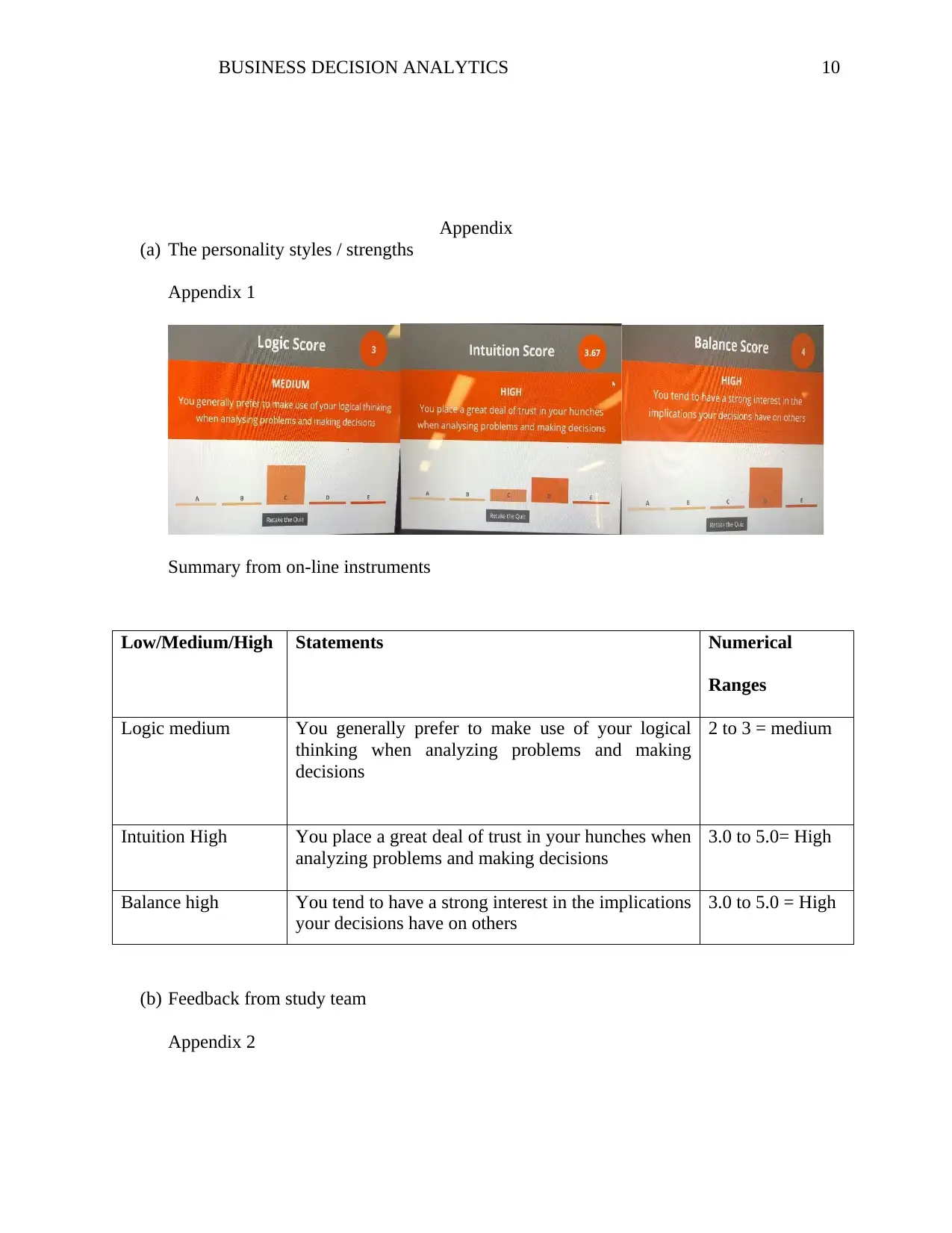
BUSINESS DECISION ANALYTICS 10
Appendix
(a) The personality styles / strengths
Appendix 1
Summary from on-line instruments
Low/Medium/High Statements Numerical
Ranges
Logic medium You generally prefer to make use of your logical
thinking when analyzing problems and making
decisions
2 to 3 = medium
Intuition High You place a great deal of trust in your hunches when
analyzing problems and making decisions
3.0 to 5.0= High
Balance high You tend to have a strong interest in the implications
your decisions have on others
3.0 to 5.0 = High
(b) Feedback from study team
Appendix 2
Appendix
(a) The personality styles / strengths
Appendix 1
Summary from on-line instruments
Low/Medium/High Statements Numerical
Ranges
Logic medium You generally prefer to make use of your logical
thinking when analyzing problems and making
decisions
2 to 3 = medium
Intuition High You place a great deal of trust in your hunches when
analyzing problems and making decisions
3.0 to 5.0= High
Balance high You tend to have a strong interest in the implications
your decisions have on others
3.0 to 5.0 = High
(b) Feedback from study team
Appendix 2
Paraphrase This Document
Need a fresh take? Get an instant paraphrase of this document with our AI Paraphraser

BUSINESS DECISION ANALYTICS 11
My group members; Luiz, Alexandra and Arman think that I’m a mix of intuition
decision maker with logical type.
My group members; Luiz, Alexandra and Arman think that I’m a mix of intuition
decision maker with logical type.
1 out of 11
Related Documents
Your All-in-One AI-Powered Toolkit for Academic Success.
+13062052269
info@desklib.com
Available 24*7 on WhatsApp / Email
![[object Object]](/_next/static/media/star-bottom.7253800d.svg)
Unlock your academic potential
Copyright © 2020–2025 A2Z Services. All Rights Reserved. Developed and managed by ZUCOL.





